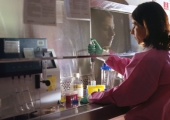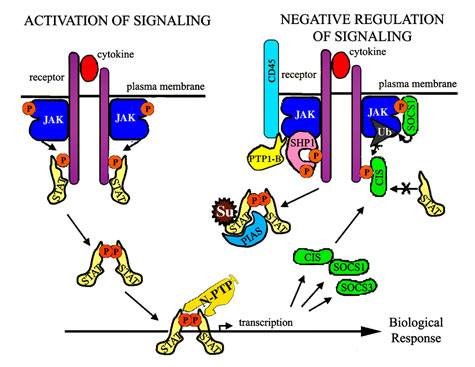You are here:
Research
- Branch Overview
- Chemical Immunology Section
- Genomic Integrity and Immunity Group
- Lymphocyte Cell Biology Section
- Molecular Inflammation Section

Lymphocyte Cell Biology Section
John O'Shea, M.D.
Section Chief, Lymphocyte Cell Biology Section
Molecular Immunology and Inflammation Branch (MIIB)
Phone: (301) 496-6026
Fax: (301) 402-0012
E-mail: osheajo@mail.nih.gov
Research Overview
The Lymphocyte Cell Biology Section studies the molecular basis by which cytokines, the extracellular messengers of the immune system, regulate the development and function of lymphocytes and other immune cells. By identifying the various biochemical steps through which cytokine binding to its receptor on the cell surface ultimately activates transcription factors and regulates gene expression in the nucleus, the researchers hope to gain insights into the pathogenesis of immunologic diseases and perhaps find new therapeutic targets.
Cytokine receptors associate with a class of protein tyrosine kinases termed Janus kinases or Jaks. The Lymphocyte Cell Biology Section discovered Jak3, which is predominantly expressed in immune and hematopoietic cells They demonstrated that Jak3 associates with the common γ chain (γc), a cytokine receptor that is a shared subunit used by interleukin-2 (IL-2), IL-4, IL-7, IL-9, IL-15 and IL-21. Jak3 is essential for signaling by this class of receptors.

Mutations of γc are responsible for X-linked severe combined immunodeficiency (X-SCID), characterized by the absence of T lymphocytes and natural killer cells, normal to elevated numbers of nonfunctional B lymphocytes, and marked hypoplasia of lymphoid tissues. Patients are highly susceptible to various pathogens and typically require reconstitution of a competent immune system through allogeneic bone marrow transplantation. Because of the association of Jak3 and γc, it was suspected that some forms of SCID might also be due to Jak3 mutations. In collaboration with researchers in Italy and Duke, the Section discovered that Jak3 mutations are responsible for some forms of autosomal recessive SCID. For more information on Jak3 mutations, please see the entry in Online Mendelian Inheritance in Man (OMIM) and the entry in the Human Gene Mutation Database (http://www.hgmd.cf.ac.uk/ac/index.php). Patients suspected of having Jak3 mutations or other problems may be seen at the NIH Clinical Center under Protocol 99 AR0004.
Because of the importance of Jak3 in the development and function of the immune system, understanding Jak3 structure/function remains a major focus of the Section's work. Additionally, since Jak3 deficiency results in SCID, the researchers have proposed that Jak3 would be an attractive target for novel immunosuppressive drugs. Furthermore, as Jak3 is only expressed in immune cells, drugs that suppress Jak3 function should not produce effects outside the immune system. The Section has a collaboration with industry to help identify such agents. (For more information on Jak3 and Jak3- SCID, please see research summaries for Massimo Gadina, Sigrun Hofmann and Yong-jie Zhou).
The section also studies the function of IL-12, which plays a central role in cell-mediated immune responses by promoting Th1 cell differentiation, inducing the production of proinflammatory cytokines, and enhancing the proliferation and cytotoxic activity of natural killer cells. The section demonstrated that IL-12 binding to its receptor induces the tyrosine phosphorylation of Jak2 and Tyk2, which associate with the IL-12 receptor.
Upon activation, Jaks phosphorylate the receptor chains, thereby providing docking sites for downstream signaling molecules, such as the signal transducers and activators of transcription (STATs). The STATs that bind to the phosphorylated receptors are themselves phosphorylated, which allows them to dimerize, translocate to the nucleus, and stimulate the expression of cytokine-responsive genes. The section demonstrated that IL-12 induces the tyrosine phosphorylation and activation of STAT4, the key molecule in the intracellular transduction cascade activated by IL-12 stimulation. (For more information on IL-12 and STAT4, please see research summaries for Massimo Gadina, Akio Morinobu and Masato Moriguchi).
More recently the laboratory identified Cybr, a cytokine-inducible gene found in microarray experiments, as a regulator of Cytohesin-1. Cytohesin-1 is pleckstrin homology domain and Sec-7 domain containing protein that is reported to regulate integrin-mediated adhesion (For details, see the entries by Dr. Gadina, Agnello and Watford). Dr. Hissong is studying other cytokine-inducible genes.
The section also works in collaboration with Dr. Kastner's branch on hereditary periodic fever syndromes. The section has analyzed the regulation of familial Mediterranean fever gene (MEFV) by cytokines and contributed to the discovery that mutations of the 55 kDa tumor necrosis factor (TNF) receptor cause an autoinflammatory disease the researchers termed TNF-receptor-associated periodic syndrome (TRAPS OMIM listing).
Most recently, mutations of CIAS1 were found to be associated with the disease NOMID (neonatal onset multisystem inflammatory disease). Discussion of this work can be found in Drs. Watford and Hofmann's entries.
Selected Publications
Wei L, Laurence A, Elias KM, O'Shea JJ. IL-21 is produced by TH17 cells and drives IL-17 production in a STAT3-dependent manner. J Biol Chem. 2007 Nov 30;282(48):34605-10. Epub 2007 Sep 20.
![]()
Laurence A*, Tato CM*, Davidson TS*, Kanno Y, Chen Z, Yao Z, Blank RB, Meylan F, Siegel R, Hennighausen L, Shevach EM, O'Shea JJ. *Joint first authorship Interleukin-2 Signaling via STAT5 Constrains T Helper 17 Cell Generation. Immunity. 2007 Mar;26(3):371-81.
![]()
Chen Z, Tato CM, Muul L, Laurence A, O'Shea JJ. Distinct regulation of interleukin-17 in human T helper lymphocytes. Arthritis Rheum. 2007 Sep;56(9):2936-46.
![]()
Pesu M, Candotti F, Husa M, Hofmann SR, Notarangelo LD, O'Shea JJ. Jak3, severe combined immunodeficiency, and a new class of immunosuppressive drugs. Immunol Rev. 2005; 203:127-42.
![]()
O'Shea JJ, Pesu M, Borie DC, Changelian PS. A new modality for immunosuppression: targeting the JAK/STAT pathway. Nat Rev Drug Discov. 2004; 3(7):555-64.
![]()
See complete list of publications
Updated September 17, 2007



